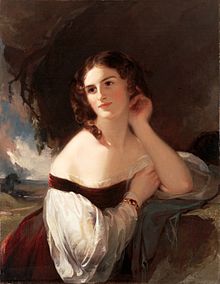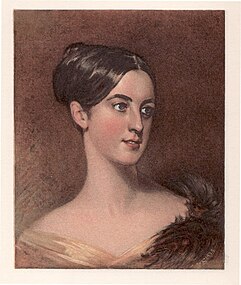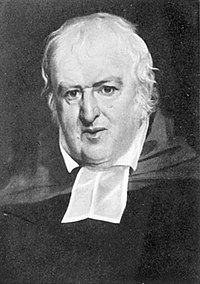Thomas Sully
Thomas Sully | |
|---|---|
 Thomas Sully in 1869 | |
| Born | June 19, 1783 |
| Died | November 5, 1872 (aged 89) |
| Occupation | Painter |
Thomas Sully (June 19, 1783 – November 5, 1872) was an American portrait painter, who was born in Britain but lived most of his life in Philadelphia. He painted in the style of Thomas Lawrence, and his subjects included Thomas Jefferson, John Quincy Adams, and Marquis de Lafayette, as well as many leading musicians and composers. He also painted landscapes and historical pieces such as Passage of the Delaware, and his work was used on United States coinage.
Life and career
Early life
Sully was born in Horncastle, Lincolnshire, England in 1783, to the actors Matthew Sully and Sarah Chester.[1] In March 1792, the Sullys and their nine children emigrated to Charleston, South Carolina, where Thomas’s uncle managed a theater. Sully made his first appearance in the arts as a tumbler at the age of 11 in Charleston.[2] After a brief apprenticeship to an insurance broker, who recognized his artistic talent, at about age 12 Sully began painting. He studied with his brother-in-law Jean Belzons (active 1794–1812), a French miniaturist, until they had a falling-out in 1799.
He returned to Richmond to learn "miniature and device painting" from his elder brother Lawrence Sully (1769–1804). After Lawrence Sully's death, Thomas Sully married his brother's widow, Sarah Annis Sully. He took on the rearing of Lawrence's children and fathered an additional nine children with Sarah. Among the children were Alfred Sully, Mary Chester Sully (who married Sully's protégé, the painter John Neagle), Jane Cooper Sully Darley, Blanche Sully, Rosalie Sully, and Thomas Wilcocks Sully.
Sully was one of the founding members of The Musical Fund Society where he painted the portraits of many of the musicians and composers.
Painting


Sully became a professional painter at age 18 in 1801. He studied portrait painting under Gilbert Stuart in Boston for three weeks. After some time in Virginia with his brother, Sully moved to New York.
He settled in Philadelphia in 1806, where he resided for the remainder of his life. In 1809 he traveled to London for nine months of study under Benjamin West.
Sully's 1824 portraits of John Quincy Adams, who became President within the year, and then the Marquis de Lafayette, appear to have brought him to the forefront of his day. His Adams portrait may be seen in the National Gallery of Art, Washington. Many notable Americans of the day had their portraits painted by him. In 1837–1838 he was in London to paint Queen Victoria at the request of Philadelphia's St. George's Society. His daughter Blanche assisted him as the Queen's "stand-in", modeling the Queen's costume when she was not available. One of Sully's portraits of Thomas Jefferson is owned by the Jefferson Literary and Debating Society at the University of Virginia and hangs in that school's rotunda. Another Jefferson portrait, this one head-to-toe, hangs at West Point, as does his portrait of General Alexander Macomb.
Sully's own index indicates that he produced 2,631 paintings from 1801, most of which are currently in the United States. His style resembles that of Thomas Lawrence. Though best known as a portrait painter, Sully also made historical pieces and landscapes. An example of the former is the 1819 Passage of the Delaware, now in the Museum of Fine Arts, Boston. The Sully painting, Portrait of Anna and Harriet Coleman, sold on September 28, 2013 for $145,000 by John M. Hess Auction Service Inc. of Manheim, Pennsylvania.
Death and legacy

Sully died in Philadelphia on November 5, 1872, where he had spent the majority of his long and successful career. He is buried in the Laurel Hill Cemetery. His book Hints to Young Painters was published after his death.
Several of Sully's portraits hang in the chambers of the Dialectic and Philanthropic Societies of the University of North Carolina. Portraits, including that of President James K. Polk, were commissioned of notable alumni from the Societies. The obverse design of the United States Seated Liberty coinage, which began with the Gobrecht dollar in 1836 and lasted until 1891, was based on his work.
His son, Alfred Sully, was a brigadier general in the Union Army during the American Civil War. Through Alfred, he is the great-grandfather of Ella Deloria, the noted Yankton Sioux ethnologist and writer; and the great-great-grandfather of Vine Deloria, Jr., Standing Rock Sioux scholar and author of Custer Died For Your Sins (1969), an American Indian civil-rights manifesto.
Sully was a great-uncle of Thomas Sully (1855–1939), the New Orleans-based architect.
Gallery of works
-
Portrait of the Artist Painting His Wife, ca. 1810, oil on canvas, Yale University Art Gallery
-
Lady with a Harp, 1818, a portrait of Eliza Ridgely, was at Hampton Mansion from the 1820s to 1945, when it was sold to the National Gallery of Art[3]
-
Portrait of the Artist, 1821, Metropolitan Museum of Art
-
Portrait of the Misses Mary and Emily McEuen, 1823, Los Angeles County Museum of Art
-
Portrait of Elizabeth McEuen Smith, 1823, oil on canvas, Honolulu Museum of Art
-
Portrait of Andrew Jackson, 1824, used for the United States twenty-dollar bill from 1928 onward
-
A Life Study of the Marquis de Lafayette, ca. 1824-1825, oil on canvas
-
Portrait of Mary Ann Heide Norris, 1830, Philadelphia Museum of Art
-
Sheet of figure studies, 1830-1839, Museum of Fine Arts, Boston
-
Jared Sparks, 1831, oil on canvas, Reynolda House Museum of American Art
-
Miss Walton of Florida, 1833, oil on canvas, a portrait of Octavia Walton Le Vert
-
Portrait of Fanny Kemble, 1834
-
Gypsy Maidens, 1839, watercolor, Brooklyn Museum
-
Macbeth in the witches' cave, 1840, Folger Shakespeare Library
-
Mother and Son, 1840, oil on canvas, Metropolitan Museum of Art, New York
-
Charlotte Cushman, 1843, Folger Shakespeare Library
-
Cinderella at the Kitchen Fire, 1843, Dallas Museum of Art
-
Engraving of Sully's portrait of Eliza, daughter of Joshua Bates of Boston (USA), and wife to the Belgian statesman Sylvain van de Weyer
-
Elizabeth/Elise Wadsworth, wife of Charles Augustus Murray
-
The Student, of Sully's daughter Rosalie (1848)
-
Portrait of Shakespeare, 1864, Folger Shakespeare Library
-
Portrait of Rev. John Andrews D.D.Provost of University of Pennsylvania
References
- ^ Barratt, Carrie Rebora. "Thomas Sully (1783–1872) and Queen Victoria". http://www.metmuseum.org. Heilbrunn Timeline of Art History. New York: The Metropolitan Museum of Art. Retrieved 7 December 2014.
{{cite web}}: External link in|website= - ^ [1]
- ^ "Lady with a Harp: Eliza Ridgely, 1818". National Gallery of Art. Retrieved 2008-02-05.
- Murray, P. & L. (1996). Dictionary of art and artists. Penguin Books. ISBN 0-14-051300-0.
- Carrie Rebora Barratt, Queen Victoria and Thomas Sully. Exhibition catalogue.Princeton: Princeton University Press, 2000
External links
- The Winterthur Library Overview of the archival collection on Thomas Sully.
- Thomas Sully at Find a Grave
- "Washington's Crossing as Docudrama", Wall Street Journal, Retrieved 03/19/2001
- [2] "Thomas Sully (1783–1872) and Queen Victoria". In Heilbrunn Timeline of Art History. New York: The Metropolitan Museum of Art


![Lady with a Harp, 1818, a portrait of Eliza Ridgely, was at Hampton Mansion from the 1820s to 1945, when it was sold to the National Gallery of Art[3]](http://upload.wikimedia.org/wikipedia/commons/thumb/2/2a/1818-Lady-with-Harp-Eliza-Ridgely-Sully.jpg/189px-1818-Lady-with-Harp-Eliza-Ridgely-Sully.jpg)




















